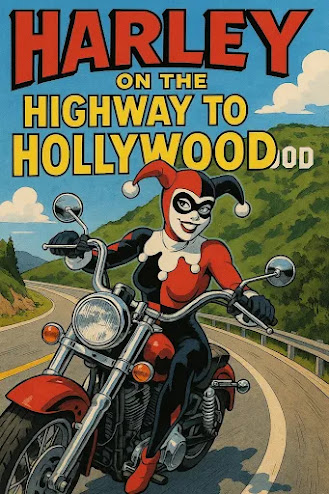“Harley on the Highway to Hollywood”
There’s a moment in *Terminator 2: Judgment Day* that transcends cinema—a cybernetic Arnold Schwarzenegger, leather-clad and stone-faced, drops from a loading dock astride a Harley-Davidson Fat Boy. The music swells. The engine growls. And for a split second, metal meets myth. That wasn’t just a motorcycle entering frame—it was an icon announcing itself.
Welcome to the untold story of Harley-Davidson’s journey through Hollywood. A journey not of product placement, but **cultural placement**. A carefully revving engine that roared into America’s subconscious—and then into the worlds.
That bike—named "Captain America"—wasn’t just a vehicle. It was **an idea on wheels**. Freedom, rebellion, nonconformity. All chrome, no apologies. With ape hangers reaching to the sky and a gas tank painted like the American flag, the Harley became a silent co-star with more philosophy than dialogue.
From then on, Harley-Davidson **shaped** movies rather than merely showing up in them.
An Exploration of the Genre
Harleys have made an appearance in all genres of film, including comedies, romantic, apocalyptic, and everything in between.
Custom motorcycles constructed on Harley frames gave *Mad Max: Fury Road* a post-oil, tribal look that expertly struck a balance between beauty and savagery. In *Pulp Fiction*, Bruce Willis’s character Butch doesn’t just steal any bike—he steals a Harley and delivers the now-immortal line: *“Zed’s dead, baby.” Translation? This does not just escape—it’s reclamation.
Even in comedy, Harleys hit different. In *Wild Hogs*, a gang of middle-aged suburbanites finds redemption and reconnection through a road trip on Harleys. The punchlines ride pillion to the underlying truth: no matter your age, background, or midlife crisis, Harley offers something honest, unfiltered, and exhilarating.
Harley doesn’t need the genre to adapt. **It rides through all of them untouched. **
Casting Call: The Harley Effect
If Hollywood actors are judged by charisma, stage presence, and silhouette, then Harleys meet the same criteria. A Sportster doesn’t feel like a Softail. A Fat Boy doesn’t move like a Dyna. Each model brings its own energy, its own typecast.
The Night Rod? Urban, aggressive, younger—a machine for vigilantes and street racers. The Heritage Classic? Stoic, weathered, romantic—perfect for road poets and haunted heroes. Directors don’t just cast Harleys; they **typecast** them.
It’s why Clint Eastwood, Mickey Rourke, Keanu Reeves, and even Ryan Gosling has all saddled up. When the scene calls for danger with depth, when the protagonist needs a silent backstory—they bring in the Harley.
Thunder Offscreen: Real Things, Real Effects
What Hollywood creates is copied around the world. And Harley knows it, too.
Following *T2*, Fat Boy's sales soared. When *Sons of Anarchy* roared onto TV screens, entire subcultures embraced the biker aesthetic, complete with black boots, patched vests, and minimalistically styled, matte-finished Harleys.In addition, celebrities like David Beckham and Post Malone joined the cult, bringing their bikes to red carpet events and fashion shows or riding them around the streets of Los Angeles. Forget about the paparazzi.
Harley evolved from a product to a **performer**—a lifestyle brand that was first influenced by celluloid before being transformed into reality.
Marketing? Nah—Mythmaking
Other companies pay for screen time. Harley-Davidson **earns it**. Not through cheesy slogans or CGI-enhanced speed sequences, but through **presence**. The kind of presence that directors crave when they want authenticity, attitude, and something that whispers, “This character doesn’t play by the rules.”
It’s that silent agreement between bike and viewer. You see the Harley, and you *know* who that person is—even before they speak.
That’s not advertising. That’s **alchemy**.
The Fade into Future Frames
In the age of electric engines, self-driving cars, and AI protagonists, Harley’s cinematic journey is far from over. Livewire—their all-electric motorcycle—has already started to appear in futuristic thrillers, offering a new chapter in how rebellion is visualized on screen.
The thunder might be quieter. The chrome may be swapped for carbon fiber. But the spirit? Still pure rebellion. Still cinematic gold.
So, whether it's rolling out of a dusty bar in an indie film, leading a high-speed chase in a cyberpunk blockbuster, or showing up in a romantic montage about rediscovering life—Harley’s not just in the shot.
It **is** the shot.
Because in Hollywood, legends aren’t made.
They ride in.
Two wheels at a time.



Comments
Post a Comment